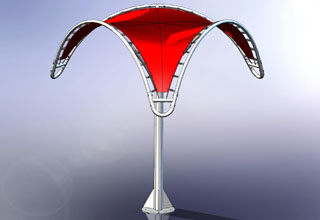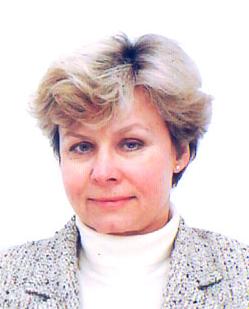Designing for the 21st century
Professor Wanda Lewis, School of Engineering
Published in July 2010
The use of tensioned fabric in architecture necessitates a collaboration between engineers and designers from the beginning. Professor Lewis shares her experiences researching tensioned fabric structures, focussing on the potential of rigid minimal forms.
 Fabric is increasingly being relied upon by innovative architects to create new shapes for our skyline. Instantly impressive, as the Millennium Dome demonstrates, these elaborate tents require a unique and long winded development process. Fabric has non-linear properties which means that it is very difficult to predict how the material will stretch and warp under strain; models have to be repeatedly constructed and adjustments made during the design process. Sometimes adjustments are needed after the structure has been built.
Fabric is increasingly being relied upon by innovative architects to create new shapes for our skyline. Instantly impressive, as the Millennium Dome demonstrates, these elaborate tents require a unique and long winded development process. Fabric has non-linear properties which means that it is very difficult to predict how the material will stretch and warp under strain; models have to be repeatedly constructed and adjustments made during the design process. Sometimes adjustments are needed after the structure has been built.
As part of the “Design for the 21st Century” project ran by Warwick Engineering Department in collaboration with the Courtauld Institute, the programme ran an internal design competition to come up with a fabric shade structure to stand outside a coffee shop. The design brief stated that the sunshade should be an attractive feature for the frontage and entice people to spend more time at the cafe. Eventually, a three prong fork holding up a single dome design was chosen and made into a prototype. Prof Lewis produced the design calculations managed the production of the prototype, which was a quarter of the real-life size. She was assisted in her task by her project students, her research fellow, John Brew.
The prototype structure was manufactured by technicians from the Engineering Department: Richard Kaser and Paul Hedley. During the design process, Prof Lewis found herself being dragged into the troubled world of the architect, ‘fighting forces’ to make sure the end result looked good: "After years of preaching that structures must have efficient minimal forms I suddenly got caught in the trap of appreciating aesthetics. The frame undergoes complex action involving bending, compression and torsion that ideally it should not have,” explained Prof Lewis, “I became more sympathetic to art forms and better understood the architect’s predicament.”
Traditionally, engineers and architects are at odds, with the engineer being isolated from the initial/conceptual design process. Interestingly, it is specifically the use of tensioned fabric that necessitates that the two groups put their heads together: “The difference between conventional structures involving steel and concrete, and those using fabric, is that the latter requires the engineer to be part of the design conceptualisation. Understanding the way the fabric behaves is so complex.”
Being involved in the collaboration with the Courtauld, which led to testing the stress-strain profile of artist’s canvases, further inspired Prof Lewis to think more carefully about her working practices: “I realised that a structural engineer’s design process is more like artistic practice than I thought. We share a concern for form, asking ourselves how best to achieve a desired shape. The process is iterative, trying out different options, like when a painter tries to mix the right colour. The public do not see this process.”
In order to educate outsiders about engineers' methods, Prof Lewis took courage from her artist collaborators and staged an exhibition that expands upon her work on minimal forms. The exhibition took place at the International Digital Laboratory at Warwick, a venue made available by Lord S. K. Bhattacharyya, Director of WMG. The event proved an excellent means of communication: “Visitors included, for example, a nine-year-old girl, on one hand, and an engineer dealing with computational stress analysis for thirty years, on the other; both of them found the exhibition inspiring, which was very satisfying for me".
Minimal forms are optimal structures that offer the maximum strength and stability with minimum weight and are often exemplified in nature. The cafe umbrella, for example, resembles an open flower. Soap film, the substance that makes the outside of bubbles, when it is stretched between some boundaries creates a surface which is extra special - it has constant tension everywhere.
If a fabric had this quality, it would be much more resilient to tear and rips when it is put under strain and, therefore, would be a very useful building material: “Manufacturers are aiming to develop fabrics with this property. They get close to it by layering the material with coats of lacquer, but we are not quite there yet.” The special quality of soap film makes it invaluable when trying to conceptualise forces acting on a roof membrane: it will always create an optimal shape when put under pre-stress.
One can use soap film models to come up with new shapes, but this changes the normal order of progress - usually a designer will think up what they want and then look into how they are going to build it. When working with soap film you begin by setting some restrictions - in the case of a fabric roof supported by columns, you would start by deciding on the position and size of the columns. The designer can then use a soap film (or a fabric) model to visualise the best shape for the fabric to take. If they are not happy with the resulting look, the trick is to keep changing the initial supports/boundaries until they get a shape that they are satisfied with.
Smooth curves and organic undulations are characteristic of minimal forms. Sharp angles and rectangular shapes do not feature. Prof Lewis has moved on from investigating flexible minimal forms (which are constructed using fabric) and is now looking at rigid minimal forms. Rigid minimal forms look similar to coral and have started to inspire futuristic designs such as the Taichung Opera House.
They have the same special property - they have maximum strength and stability with minimum weight - but rigid minimal forms have not recieved as much attention as their flexible counterparts. Engineers hypothesise that the cavernous spaces inside rigid minimal forms might have various properties, including good acoustics or efficient heat conduction. These properties will make them very useful shapes to incorporate into building designs.
Recently rigid minimal forms have been discovered in the spines of sea urchins, for example. They retain the advantage of being super strong and stable even on a microscopic scale. Prof. Lewis made use of the rapid prototyping facilities within Warwick Manufacturing Group (managed by Dr. Greg Gibbons) and was able to get several models made to a much larger scale, to show what these rigid minimal forms look like.
Since a relatively small amount of research has been done on rigid minimal forms, Prof. Lewis has received a lot of interest in her work. There is, potentially, a multitude of possible uses for manufactured rigid minimal forms structures. There is hope that they might prove an effective form to facilitate the growth of human tissue, for example.
With so many possible applications her work might inspire a whole host of collaborations between engineers and professionals from other disciplines. This would be a pleasing result for a project that started as a result of a novel partnership between the EPSRC (Engineering and Physical Sciences Research Council) and AHRC (Arts and Humanities Research Council) under the Designing for the 21st Century scheme.
 Professor Lewis's current project awarded by the AHRC/EPSRC under 'Designing for the 21st Century' scheme involves a study of tension fabric as a medium for sculpturing architectural enclosures, but also as a material for structural conservation of easel paintings and as artist's canvas. Her research interests include form-finding and stress analysis applied to not only flexible tension structures (such as prestressed cable nets and membrane roofing forms), but also rigid-type engineering components. The main focus of the work is the achievement of optimum structural form by using nature's own design principle: maximum stability and strength with minimum weight. The work has been applied to products from the automotive and aerospace industries, including the convertible roof for the Jaguar XK8, and, at a feasibility level, compressor blades. Her teaching interests are Innovative Structural Forms, Design, Mechanics, Civil Engineering Materials. Professor Lewis was a member of School Research and Innovation Group, was Head of Civil Engineering (C&M Division) from 2001-2003, and is the EU Funding Scheme Coordinator.
Professor Lewis's current project awarded by the AHRC/EPSRC under 'Designing for the 21st Century' scheme involves a study of tension fabric as a medium for sculpturing architectural enclosures, but also as a material for structural conservation of easel paintings and as artist's canvas. Her research interests include form-finding and stress analysis applied to not only flexible tension structures (such as prestressed cable nets and membrane roofing forms), but also rigid-type engineering components. The main focus of the work is the achievement of optimum structural form by using nature's own design principle: maximum stability and strength with minimum weight. The work has been applied to products from the automotive and aerospace industries, including the convertible roof for the Jaguar XK8, and, at a feasibility level, compressor blades. Her teaching interests are Innovative Structural Forms, Design, Mechanics, Civil Engineering Materials. Professor Lewis was a member of School Research and Innovation Group, was Head of Civil Engineering (C&M Division) from 2001-2003, and is the EU Funding Scheme Coordinator.
